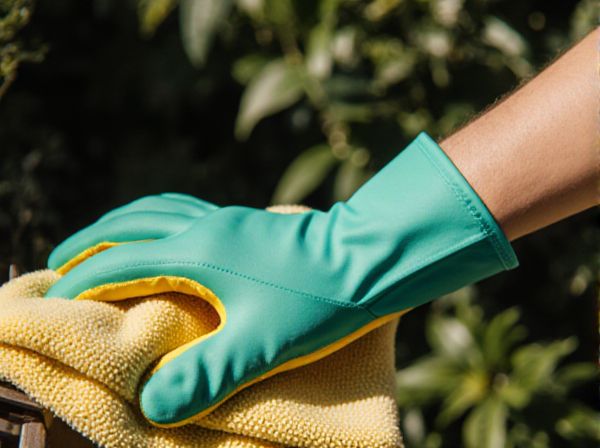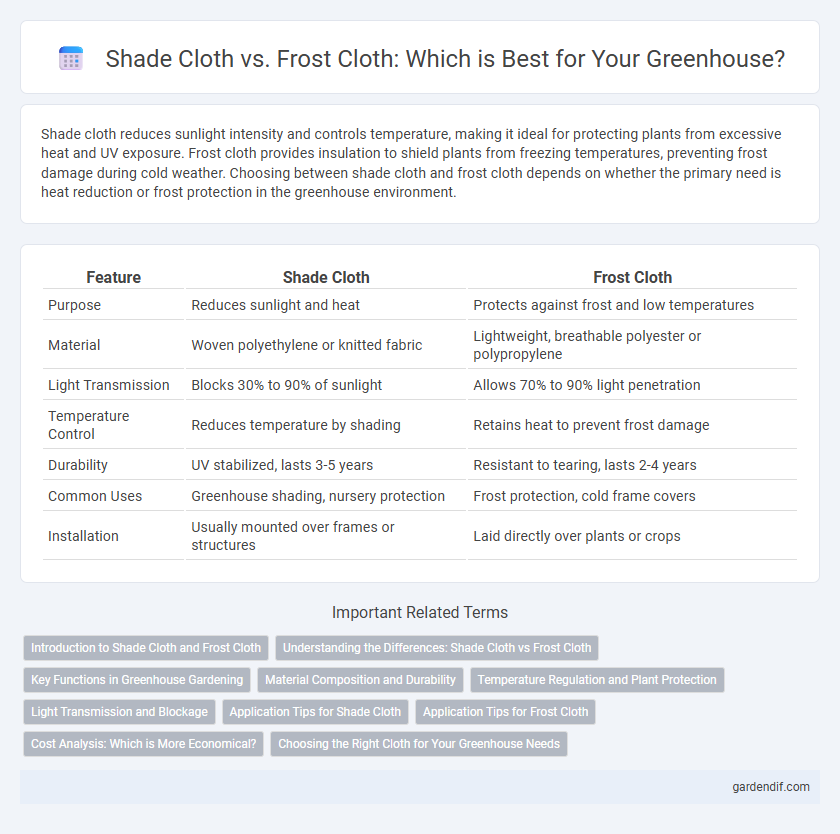
Shade Cloth vs Frost Cloth Illustration
Shade cloth reduces sunlight intensity and controls temperature, making it ideal for protecting plants from excessive heat and UV exposure. Frost cloth provides insulation to shield plants from freezing temperatures, preventing frost damage during cold weather. Choosing between shade cloth and frost cloth depends on whether the primary need is heat reduction or frost protection in the greenhouse environment.
Table of Comparison
| Feature | Shade Cloth | Frost Cloth |
|---|---|---|
| Purpose | Reduces sunlight and heat | Protects against frost and low temperatures |
| Material | Woven polyethylene or knitted fabric | Lightweight, breathable polyester or polypropylene |
| Light Transmission | Blocks 30% to 90% of sunlight | Allows 70% to 90% light penetration |
| Temperature Control | Reduces temperature by shading | Retains heat to prevent frost damage |
| Durability | UV stabilized, lasts 3-5 years | Resistant to tearing, lasts 2-4 years |
| Common Uses | Greenhouse shading, nursery protection | Frost protection, cold frame covers |
| Installation | Usually mounted over frames or structures | Laid directly over plants or crops |
Introduction to Shade Cloth and Frost Cloth
Shade cloth is a woven or knitted fabric designed primarily to reduce sunlight intensity and control temperature inside greenhouses, improving plant growth conditions. Frost cloth is a lightweight, breathable material used to protect plants from freezing temperatures by trapping heat and preventing frost damage. Both fabrics serve distinct purposes in greenhouse management, optimizing environmental conditions for various crops.
Understanding the Differences: Shade Cloth vs Frost Cloth
Shade cloth and frost cloth serve distinct purposes in greenhouse gardening, with shade cloth designed to reduce sunlight intensity and protect plants from overheating, typically blocking 30-90% of solar radiation. Frost cloth, on the other hand, provides insulation against cold temperatures, safeguarding plants from frost damage by trapping heat close to the foliage. Selecting the appropriate cloth depends on the specific climate challenges and plant needs within the greenhouse environment.
Key Functions in Greenhouse Gardening
Shade cloth regulates sunlight exposure and reduces heat inside greenhouses, protecting plants from sunburn and excessive temperature stress. Frost cloth provides insulation against cold temperatures, preventing frost damage by trapping heat and maintaining a warmer microclimate around sensitive plants. Using shade cloth enhances photosynthesis control, while frost cloth extends the growing season by safeguarding crops from freezing conditions.
Material Composition and Durability
Shade cloth is typically made from knitted polyethylene or woven polypropylene, designed to filter sunlight and reduce heat while allowing airflow, offering moderate durability suited for long-term seasonal use. Frost cloth, often composed of lightweight spunbonded polyester or polypropylene fibers, provides insulation by trapping warmth and protecting plants from freezing temperatures, with durability that withstands cold conditions but may degrade faster under constant UV exposure. Both materials balance breathability and protection, but shade cloth excels in UV resistance and longevity, whereas frost cloth prioritizes thermal insulation with slightly less durability under prolonged sunlight.
Temperature Regulation and Plant Protection
Shade cloth effectively reduces greenhouse temperatures by blocking up to 90% of sunlight, preventing heat stress and sunburn on plants. Frost cloth provides insulation by trapping heat close to plants, allowing temperatures to remain 5-10degF higher during cold nights and protecting against frost damage. Both materials enhance crop yield by optimizing thermal conditions, with shade cloth favoring heat reduction and frost cloth improving cold tolerance.
Light Transmission and Blockage
Shade cloth provides controlled light transmission by filtering sunlight to reduce intensity, typically allowing 30-70% of light to pass through depending on its density. Frost cloth primarily offers light blockage to protect plants from freezing temperatures while still permitting some light and moisture penetration, usually transmitting around 50-80% of light but blocking cold air and frost buildup. Choosing between shade cloth and frost cloth depends on whether the priority is reducing solar radiation or preventing frost damage while maintaining sufficient light for plant growth.
Application Tips for Shade Cloth
Shade cloth is ideal for protecting plants in greenhouses from excessive sunlight and heat, effectively reducing temperature by up to 20%. When applying shade cloth, ensure it is securely fastened above the plants, allowing adequate air circulation to prevent humidity buildup and mold growth. Select a cloth with appropriate shading density, typically between 30% and 70%, based on the specific light requirements of your crops.
Application Tips for Frost Cloth
Frost cloth is specially designed to protect plants from freezing temperatures by trapping heat and allowing light and moisture to penetrate, making it ideal for delicate crops during cold snaps. When applying frost cloth, ensure it directly covers the plants with edges securely anchored to prevent wind lift while maintaining ventilation to avoid excess humidity buildup. For maximum protection, use frost cloth during clear, cold nights and remove it during the day to allow sunlight exposure and prevent overheating.
Cost Analysis: Which is More Economical?
Shade cloth typically costs less upfront than frost cloth due to its simpler polyethylene material and lower manufacturing complexity, making it a budget-friendly option for basic sun protection. Frost cloth, designed with woven or nonwoven polypropylene to provide insulation against cold temperatures, carries a higher price but offers enhanced plant protection in frost-prone environments. Evaluating long-term expenses, frost cloth may prove more economical by reducing crop loss and damage, outweighing its initial higher investment compared to the short-term savings of shade cloth.
Choosing the Right Cloth for Your Greenhouse Needs
Shade cloth and frost cloth serve distinct purposes in greenhouse management, with shade cloth primarily reducing sunlight intensity and protecting plants from excessive heat, while frost cloth provides insulation against cold temperatures and frost damage. Selecting the right cloth depends on your greenhouse climate needs: use shade cloth in hot, sunny environments to prevent plant stress and frost cloth in colder regions to safeguard crops from freezing conditions. Both materials vary in density and durability, so assess your local weather patterns and plant sensitivity to optimize growth and ensure year-round protection.
Shade Cloth vs Frost Cloth Infographic

 gardendif.com
gardendif.com